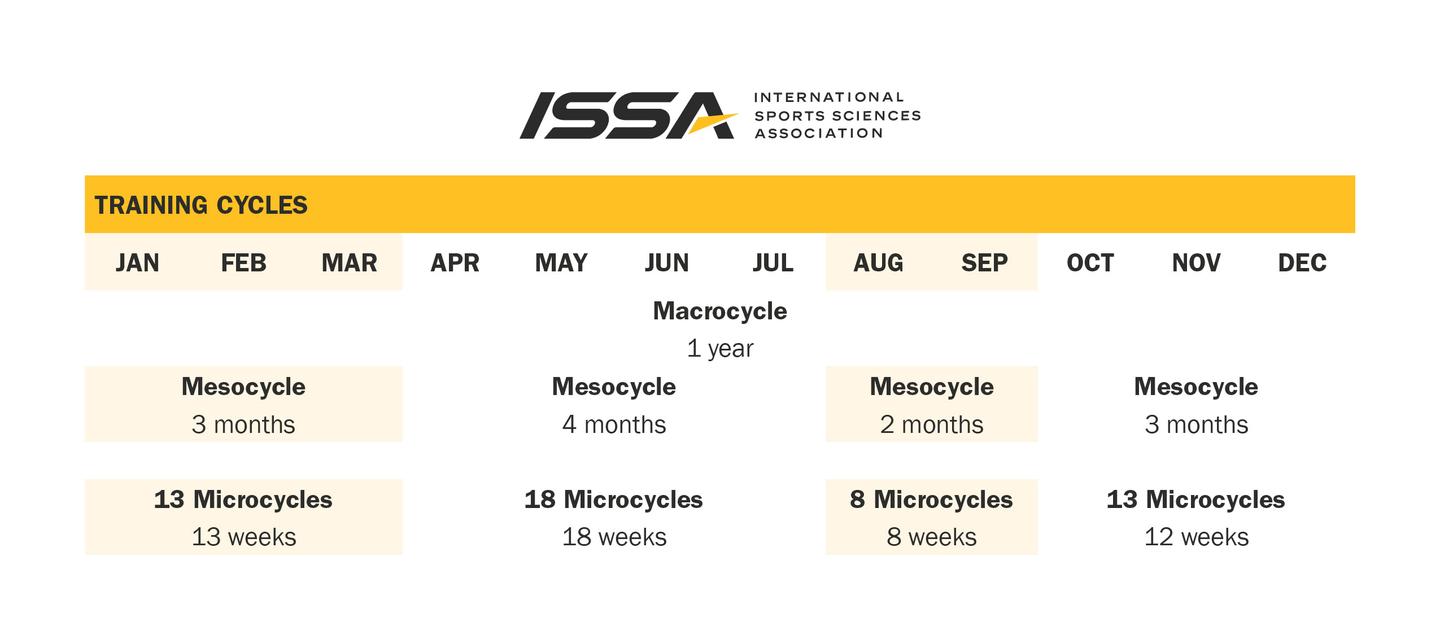
When to Change Your Workout Routine
Reading Time: 7 minutes 24 seconds
BY: ISSA
DATE: 2021-06-30
Consistency and a proper diet are the keys to an effective fitness program. It doesn't matter if a client is training for hypertrophy, endurance, athletic performance, or strength. If they are not seeing success, they are likely skimping out on the things that will make them successful and they may or may not report it to you.
By definition, a routine is a sequence of actions regularly followed. Humans thrive on predictability and perform best, in most cases, with a consistent routine. However, a training routine has a timeline. Every successful personal trainer creates an exercise routine with the forethought of periodization, the client's fitness goals, and the client's abilities. It takes attention to detail and the flexibility to change an exercise program in progress to determine when a client's training needs to be changed for their ultimate success.
Why Change Your Workout?
Clients walk into a gym or hire a personal trainer because they have a goal. For some, it's as simple as maintaining their fitness. For others, they want to improve, get stronger, or see some weight loss. Personal trainers are uniquely qualified to assess a client's goals and create an exercise program that will prevent injury and help them reach their objectives. This includes the understanding of how the body works and when to change things up to keep clients progressing.
All clients can benefit from resistance training no matter what their goal. Meanwhile, traditional bodybuilding methods are not appropriate for everyone. High-intensity interval training is a great way to incorporate cardiovascular training, resistance training, and endurance training in a fun, fast-paced way for physically able clients. It's up to a fitness professional to know when and how to incorporate the different training styles into a client's exercise routine.
The human body adapts to the stresses placed on it. There are three main principles of fitness at play:
1. The Principle of Progression - this states that training must progress, and the intensity must increase over time for the body to force physiological adaptation. Simply put, to get stronger, bigger, or faster, the training stimulus must become gradually more challenging. Acute training variables like frequency of training, intensity or effort, the time spent training, and the methods used are often manipulated. These variables make up the acronym FITT—frequency, intensity, time, and type.
2. The S.A.I.D. Principle - S.A.I.D. stands for the specific adaptations to imposed demands. This principle states that the body will adapt to the specific demands placed upon it. A runner who runs often will see improved cardiovascular ability while a football player who squats often should see improvements in their lower body power, strength, and, with the proper variables, muscle size gains. Running will not help the runner build muscular strength and squatting heavy loads will not help the football player improve their cardiovascular endurance. Each training style and exercises have specific demands which are addressed and, with the right stimulus, improved.
3. The Overload Principle - this principle goes hand-in-hand with the principle of progression and is the best example of why a client should change up their training periodically. It states that to improve, a person must continually work harder by increasing acute variables like load, time under tension, or speed to see continued adaptation. Once the body adapts to a current routine, the limits must be pushed to continue to see changes—the system must be overloaded.
With these fitness principles in mind, there are many variables in a training session that can be changed including:
Reps
Weight
Exercise selection
Tempo
Time under tension
Volume
Frequency (of training sessions and of a specific exercise)
Intensity
Each variable is closely related, but independent of the next. For example, with a biceps curl. A typical tempo may be a 1 count elbow extension to lower the weight, no pause at the bottom, and a 1 count elbow flexion to curl the weight. This is a total time under tension for the repetition of 2 seconds. If 10 reps are completed, that's 20 seconds total for the set. A slower tempo—3 count elbow extension, a 1 count pause, and a 3 count for elbow flexion—means the total time under tension is 7 seconds per rep and 70 seconds total for the set.
In this case, changing the tempo of the biceps curl affects the time under tension making the movement more of an endurance exercise (slower tempo and higher time under tension) versus strength (faster tempo and lower time under tension).

Benefits of Switching It Up
There are many known benefits for changing up an exercise routine. First, as the fitness principles address, the body needs progression and a challenge to cause adaptations. A client who is seeking weight loss will need to create a calorie deficit and, potentially, increase their cardio output. This will increase the number of calories they are expending in comparison to the number of calories they consume daily. The result will be a negative energy balance- weight loss. With a carefully calculated calorie deficit, the weight lost will be body fat and not muscle mass!
A client looking to improve their cardiovascular endurance will need to change their training stimulus to challenge their heart muscle and heart rate more over time. For example, setting a 10-minute mile pace (6 miles per hour) to begin their training and challenging themselves to improve that pace as their training continues. Incremental changes are all they need, but the progress and overload will challenge their cardiovascular system to deliver oxygen faster and more effectively. The resulting adaptation is that their heart rate will not elevate as high when they push harder. This cardiovascular efficiency means that, over time and with the right effort, an 8-minute mile (7.5 miles per hour) can become their new norm!
When challenging the body with progressions of load, speed, reps, etc., there is an opportunity to change howa client trains. When changing up other acute training variables, the type and intensity are important ones to hone in on. This is when a personal trainer can introduce high-intensity interval training or a new style of lifting. For example, TABATA style intervals to raise the heart rate and challenge muscular and cardiovascular endurance. Or the use of a higher volume of reps to challenge muscular endurance specifically for a client who typically lifts for strength or hypertrophy as with the biceps curl example. In this case, the repetitions would be 13 or more instead of 6 to 12. The load used will likely be less, but the overall time under tension- the time spent performing the set of an exercise—will increase dramatically!
These manipulations are enough to shock the body, break away from the client's normal workout program, and promote a differentadaptation. Not only will your client endure a new, challenging workout, but they will also continue to see results. The addition of different training variables keeps the body adapting continuously and helps to avoid the plateaus and boredom of repetitive workouts.
Exercise Compliance
Speaking of boredom, why would a trainer care if a client is bored? Well, the bottom line is exercise compliance. This is defined as the adherence to a fitness regimen designed to help a client reach their goals. If a client is doing the same workouts day in and day out with the same level of intensity, they are bound to become disengaged. They will likely stop seeing results and, in turn, be unmotivated to continue to train and follow their training program. In this case, a fitness professional can lose a client and the client will give up on their progress. It's a losing situation for all involved.
Personal trainers have the opportunity to change many of the variables of fitness to keep clients engaged and progressing. The most successful trainers will share their periodized program plan with clients as they develop it and inform them of any changes along the way. This builds a relationship of transparency and trust and shows the client that the trainer is focused on their goals and success as much as they are!
How Often To Change It Up
Manipulation of training variables and trying new training styles doesn't have to happen every week. In fact, mesocycles of training often last 4 to 16 weeks based on the client's goals. Recall that periodization plans an exercise program from the overall goal and timeline and breaks it down into manageable pieces. For example, based on a 12-month training macrocycle:

A typical time to plan a change in variables is as one mesocycle ends and another begins. However, this is a general guideline, not a hard and fast rule! Training protocols can take 2 to 4 weeks or more to yield results, so frequent changes like every week or every other workout may have the opposite effect.
When Is the Right Time?
The ideal time to change up a client's workouts will be when they hit a plateau and stop seeing results. This stresses the importance of periodic assessments. Circumference measurements, body fat measurements, movement assessments, and strength assessments are tools a trainer has at their disposal to determine if a training protocol is working. If the measurements and assessments are improving, stay the course. If progress has slowed or reversed, it may be time to change things up!
Trainers can also use exercise compliance to determine if a client is in need of a regimen change. The trainer-client relationship is a big part of training success for both parties. A trainer must pay attention to the needs and outcomes of each individual they serve, and a client must trust and believe in their trainer.
There are several reasons a client may have low exercise compliance and boredom is only one of those! A client may have an undisclosed injury, they may not be mentally engaged, they may lack the energy to train as prescribed, or the program may be too easy or too challenging for them to name a few. Fitness professionals must ask the right questions and remain vigilant with each client to ensure they understand the true reasons for non-compliance. Only then can they make the ideal adjustments to put the client back on the track to success.
If you'd like to learn more about training programming and the acute training variables and fitness principles, begin your ISSA Certified Personal Training course today! You'll learn about these topics and so much more as you prepare to move clients towards their fitness goals.